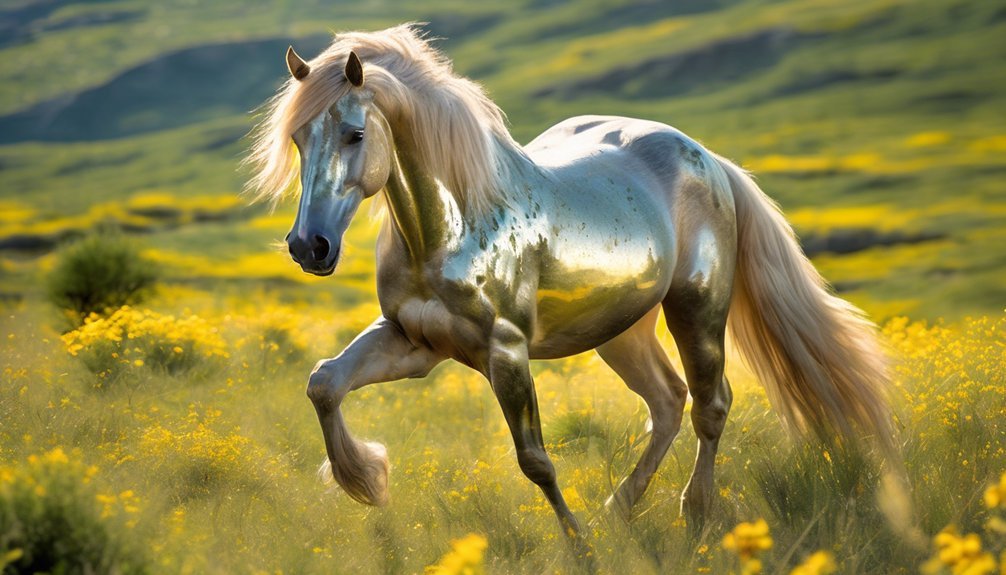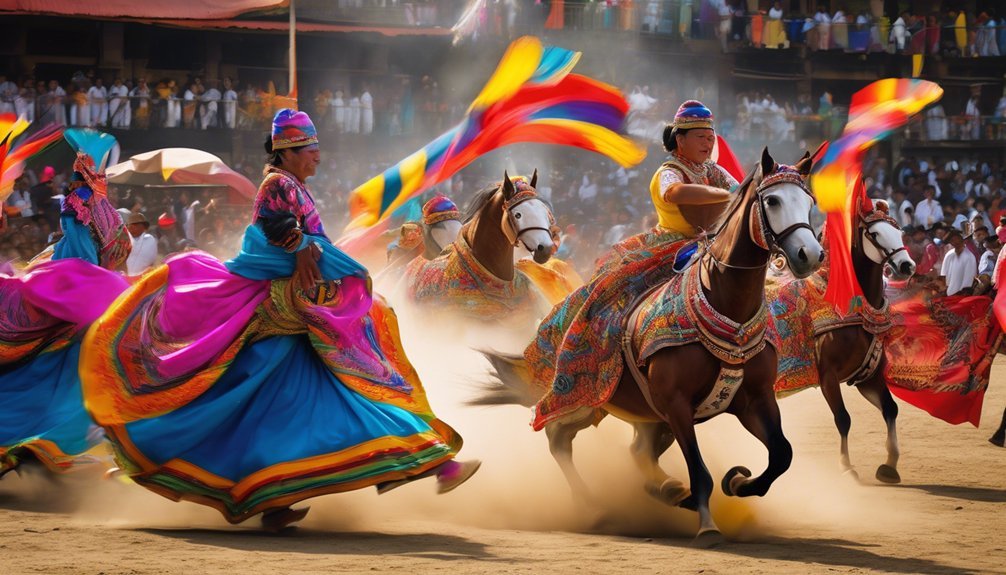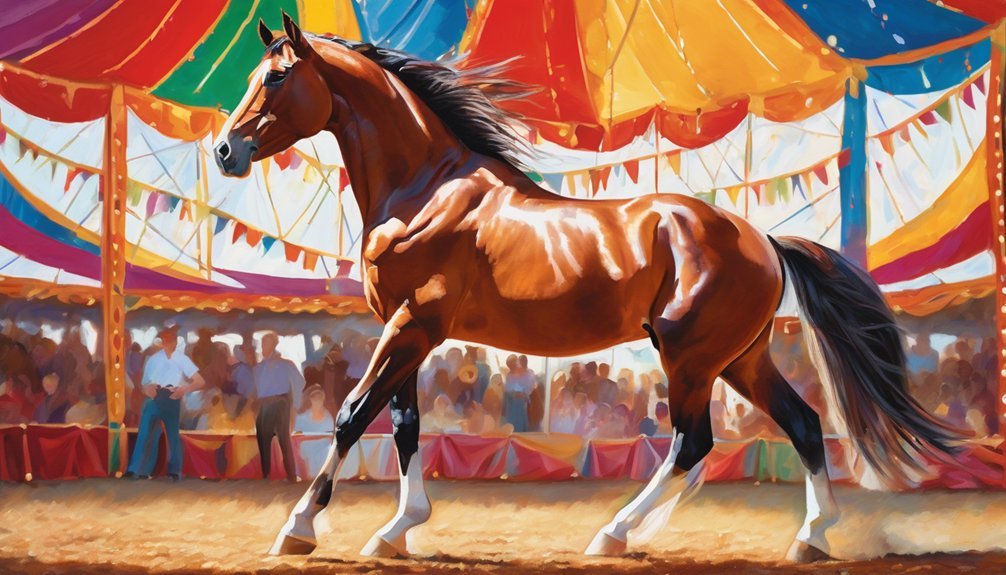
You might find it fascinating that horses, often seen as majestic creatures, can be transformed into skilled performers through a thoughtful training process. This journey begins with trust and communication, establishing a strong bond between horse and trainer. As you explore the methods used in circus training, you'll uncover the delicate balance between performance and compassion that shapes these remarkable animals. So, what truly goes into creating a captivating circus act?
Key Takeaways
- Building trust and rapport between horse and trainer is essential for effective circus training and performance.
- Basic commands and cues facilitate clear communication, allowing horses to understand expectations during training.
- Positive reinforcement techniques, like clicker training, enhance learning and strengthen the bond between the horse and trainer.
- Consistent training schedules and repetition help develop muscle memory and confidence in performing complex tricks.
- Prioritizing horse well-being through ethical practices ensures optimal health and enthusiasm during performances.
The Importance of Building Trust Between Horse and Trainer
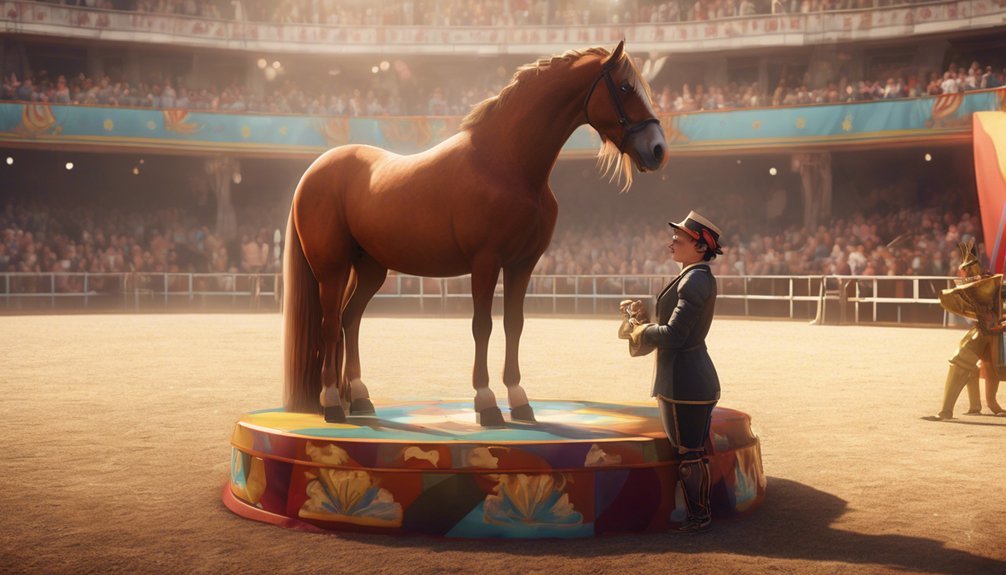
Trust is the foundation of any successful relationship, and this holds especially true in the bond between a horse and its trainer.
When you focus on building rapport, you create a safe space for your horse, allowing it to feel secure and understood. This connection enhances communication, making it easier for your horse to respond to cues and commands.
You'll notice how your horse's body language shifts, revealing its comfort or hesitation. Each interaction becomes an opportunity to deepen this trust, fostering a partnership rather than mere obedience.
By nurturing this relationship, you lay the groundwork for successful training, where both you and your horse thrive.
Basic Groundwork: The Foundation of Circus Training
As you begin the groundwork for circus training, you'll notice how crucial it's to establish trust and respect with your horse.
By introducing basic commands and cues, you create a clear communication channel, making the learning process smoother.
Utilizing positive reinforcement techniques not only encourages your horse but also strengthens the bond between you, setting a solid foundation for future tricks.
Establishing Trust and Respect
Building a foundation of trust and respect is crucial in training horses for circus acts. You'll notice that horse behavior reflects their feelings towards you. By establishing trust, you create an environment where your horse feels safe and willing to learn. It's about connecting on a deeper level, allowing your horse to understand your intentions.
| Trust Building Techniques | Observed Results |
|---|---|
| Consistent routines | Increased confidence |
| Positive reinforcement | Enhanced willingness |
| Patience and empathy | Stronger bond |
When you approach your horse with empathy, you foster a relationship built on respect. This isn't just training; it's a partnership, where both you and your horse thrive together in the world of circus performance.
Basic Commands and Cues
To successfully train a horse for circus acts, mastering basic commands and cues becomes essential, since these foundational skills shape the entire learning process.
You'll start by establishing basic signals, like voice commands and body movements, which the horse will learn to recognize. This cue recognition is crucial; it's about creating a dialogue between you and your horse.
Observe how your horse responds to each cue, noting the moments of clarity and confusion. Be patient, as every horse has a unique learning curve. Each successful response builds confidence, reinforcing the bond you share.
As you progress, you'll find that these basic commands not only facilitate training but also deepen your connection, turning each session into a shared experience of trust and understanding.
Positive Reinforcement Techniques
Once your horse has grasped basic commands and cues, the next step involves incorporating positive reinforcement techniques. You'll discover how effective clicker training can be; it's a simple yet powerful tool that bridges communication between you and your horse. As you click, you're marking the desired behavior, creating a clear connection to the reward that follows.
Establishing robust reward systems is crucial, whether it's a treat, a gentle pat, or verbal praise. Notice how your horse responds—each small success reinforces trust and enthusiasm.
Positive Reinforcement Techniques in Equine Training
While many traditional training methods rely on discipline, positive reinforcement techniques have transformed how trainers communicate with horses.
You'll notice a shift in dynamic when reward systems, like clicker training, come into play. This method encourages your horse to engage willingly, creating a bond built on trust rather than fear. Each click signifies a moment of success, making it clearer for your horse to understand what behavior you appreciate.
You're not just teaching tricks; you're nurturing a relationship. Watching your horse respond enthusiastically to rewards can be incredibly fulfilling, as it highlights their intelligence and sensitivity.
Developing Skills Through Repetition and Consistency
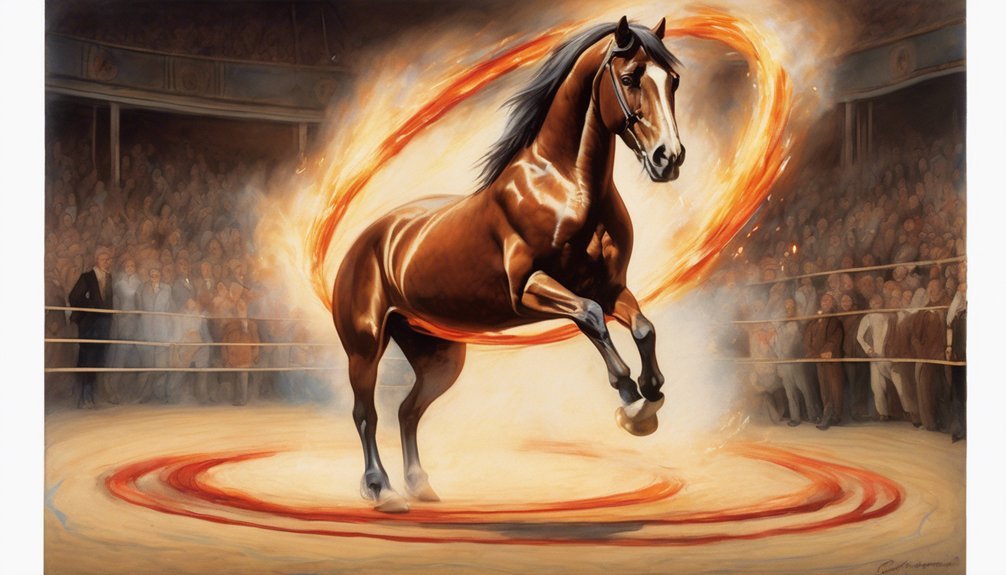
To truly master circus skills, you need to understand the power of repetition and a consistent training schedule.
Each time you practice, you reinforce the horse's learning, building their confidence and ability.
When combined with positive reinforcement techniques, this approach creates a solid foundation for impressive performances.
Importance of Repetition
As you watch a horse master a new trick, it becomes clear that repetition plays a crucial role in their training. Each time the horse performs the trick, it builds muscle memory, allowing the movements to flow more naturally.
You can almost see the light bulb moment as the horse connects the cue with the action, transforming uncertainty into confidence. This process isn't just about physical repetition; it's about forging a bond of trust between the horse and trainer.
With each repetition, you witness the gradual progression towards skill mastery, where the horse learns to anticipate the next step. It's a beautiful dance of patience and consistency, showcasing the profound impact of repetition in creating a performer capable of captivating audiences.
Consistent Training Schedule
Building on the foundation of repetition, a consistent training schedule becomes the backbone of a horse's development for circus acts.
You'll notice that training frequency plays a crucial role here; regular sessions help reinforce learned behaviors and skills. By setting a steady rhythm, you create an environment where the horse can thrive, feeling secure in the predictability of their routine.
Training duration also matters—short, focused sessions are often more effective than lengthy marathons. This approach prevents fatigue and keeps the horse engaged.
As you observe this process, you can feel the bond deepening. The horse learns to trust you, while you gain insights into their personality and needs, fostering a partnership that goes beyond mere performance.
Positive Reinforcement Techniques
While working with horses, you'll quickly realize that positive reinforcement techniques are vital for developing skills through repetition and consistency.
Using methods like clicker training, you can effectively shape behavior by marking the exact moment your horse performs a desired action. This method creates a clear communication channel between you and your horse, fostering trust and understanding.
Each click followed by a reward reinforces the behavior, encouraging your horse to repeat it. As you practice, you'll notice how your horse becomes more engaged and eager to learn.
Consistency is key; the more you repeat exercises, the stronger the learned behaviors become. With patience and empathy, you'll create a bond that empowers your horse to shine in circus acts.
Choreographing Routines: The Art of Performance
Choreographing routines for circus acts requires a deep understanding of both the horse's abilities and the emotional connection between the animal and its trainer.
You'll notice that each movement blends choreographic elements with the natural grace of the horse, creating a mesmerizing flow. As you watch, consider how performance dynamics shift with every beat—each turn, jump, and pause reflects not just training, but a partnership built on trust.
You can feel the rhythm as the trainer guides the horse, anticipating its needs and emotions. This intimacy is what transforms a simple act into an extraordinary performance, inviting the audience to connect with the horse on a deeper level.
It's a beautiful dance of trust, artistry, and mutual respect.
The Role of Conditioning in Circus Acts
Conditioning plays a crucial role in preparing horses for the demanding routines of circus acts, as it shapes their physical abilities and overall endurance.
Through consistent training, horses develop conditioned responses to specific behavioral cues, allowing them to perform complex movements with precision. You might notice how these magnificent animals respond instinctively to subtle signals from their trainers, showcasing a deep bond built on trust and understanding.
Each session focuses not just on physical strength but also on mental acuity, ensuring they grasp the nuances of their routines. As you watch them perform, you're witnessing the culmination of patience and empathy, where the art of conditioning transforms them into willing partners in the enchanting world of circus performance.
Ensuring the Well-Being of Performing Horses
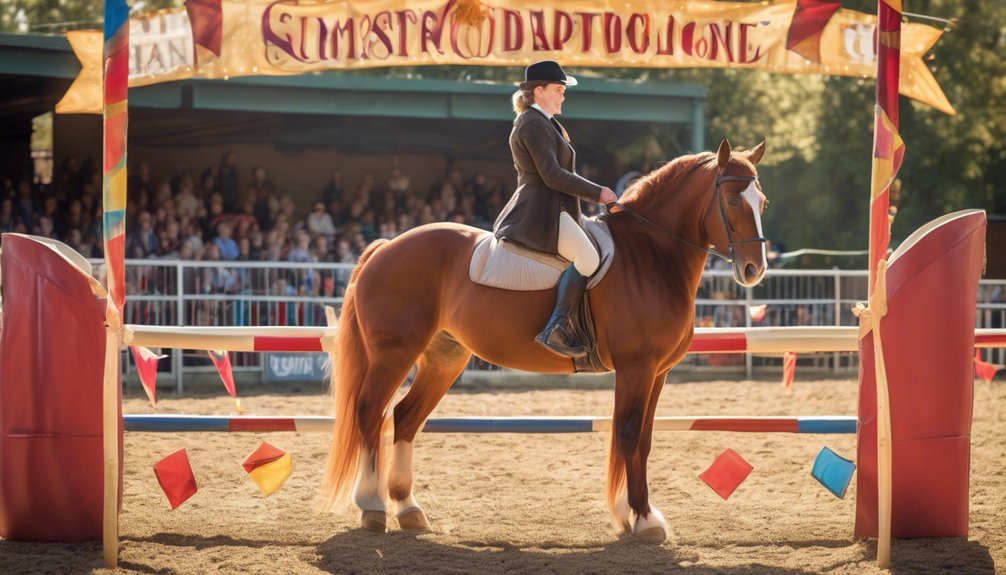
The well-being of performing horses is paramount in ensuring not only their health but also the quality of their performances.
You'll notice that when horses are treated with kindness and respect, their enthusiasm shines through in every act. Ethical training practices prioritize horse welfare, fostering trust between the animal and its trainer.
It's essential to observe each horse's individual needs, tailoring training methods to suit their temperament and comfort level. Regular veterinary care, proper nutrition, and ample downtime are vital components in keeping these majestic creatures healthy and happy.
The Bond Between Horses and Trainers: A Unique Partnership
Trust forms the foundation of the bond between horses and trainers, creating a unique partnership that thrives on mutual understanding.
This connection deepens through trainer empathy, allowing you to sense your horse's feelings and needs. As you observe their body language, you can decipher subtle cues that guide your communication. You might notice the way their ears perk up or their muscles tense, signaling their emotional state.
By responding to these signals, you foster a dialogue that strengthens your relationship. This partnership isn't just about commands; it's about building a shared language.
In this intimate space, both you and your horse learn, grow, and perform together, creating a harmonious bond that transcends the circus ring.
Frequently Asked Questions
How Long Does It Take to Train a Horse for Circus Acts?
Training duration varies, but you'll typically see significant progress in six months to a year. You'll notice their performance readiness improves with consistent, gentle guidance, fostering a bond that enriches both your journeys together.
What Types of Horses Are Best Suited for Circus Performances?
When considering the stars of the show, performance breeds shine brightest. You'll find that horses with calm temperament traits, a dash of enthusiasm, and adaptability often captivate audiences, making every performance a delightful experience for all.
Are Circus Horses Treated Differently Than Regular Riding Horses?
Circus horses often undergo specialized training techniques, focusing on performance skills. However, this can lead to concerns about animal welfare. You'll notice their treatment varies, balancing entertainment and care, reflecting a complex relationship between trainers and horses.
How Do Trainers Ensure the Safety of the Horses During Performances?
To ensure horses' safety during performances, trainers implement strict safety protocols, carefully assessing the performance environment. You'll notice how they monitor conditions, adapting routines to protect the horses while creating an engaging experience for the audience.
What Happens to Circus Horses When They Retire From Performing?
When circus horses retire, compassionate caretakers consider various retirement options. You'll see them receiving post-performance care, enjoying leisurely lives, forging bonds with new companions, and basking in blissful freedom, far from the spotlight's demanding glare.
Conclusion
In the world of circus training, trust and communication forge an extraordinary bond between horses and their trainers. Remarkably, studies show that horses can recognize their trainers' voices, demonstrating the depth of their connection. This emotional link not only enhances performance but also prioritizes each horse's well-being. As you witness their captivating acts, remember the dedication behind the scenes, where mutual respect and understanding create a partnership that shines in every graceful movement.




